Legislative Analyst's Office, December 1998
|

|
1998 Cal Facts
California's Economy
|
California Is the World's Seventh Largest Economy
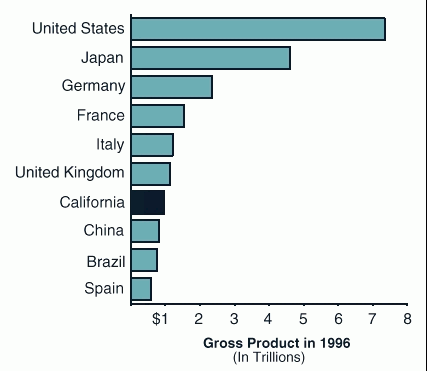
-
With total output of goods and services exceeding $1 trillion, California’s economy ranks among the largest in the world.
-
In 1996, its gross product exceeded all but six nations.
-
California’s economy is by far the largest in the United States, accounting for over one-eighth of the U.S. output of goods and services. It is over 60 percent larger than that of the second largest state—New York.
California's Economy Is Highly Diversified
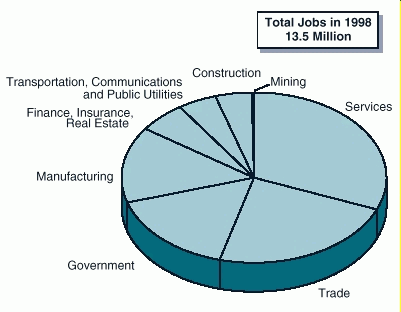
-
California has one of the most diversified economies in the nation, with workers in over 120 industries.
-
Key areas of the economy include various services-related industries—ranging from computer design and software development to multimedia and film production as well as trade and manufacturing.
-
Average earnings for industries range from below $20,000 in some personal services and temporary employment categories, to over $80,000 in some high-tech and financial services categories.
California's Job Performance In the 1990s
Wage and Salary Employment
(In Millions)
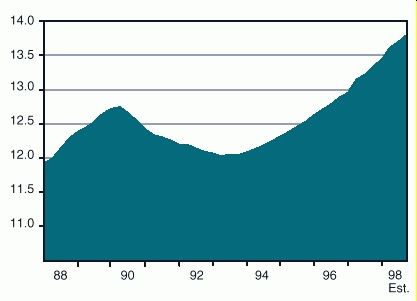
-
California’s economy went through a steep and painful recession in the early 1990s, in which the state lost over 720,000 jobs.
-
It emerged from the recession in late 1993, but it took three more years until the state recouped the jobs lost in the downturn.
-
The expansion picked up momentum in more recent years, led by such diverse sectors as international trade, movie production, tourism, and high-technology manufacturing and services.
California Employment By Major Economic Region
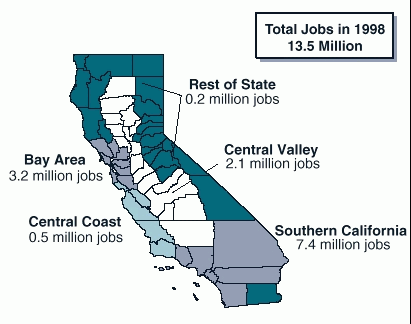
-
California’s economy can be divided into five major geographic regions, each of which has its own characteristics.
-
By far the largest region is the six-county area of Southern California, which accounts for well over one-half of the jobs in the state.
-
The other large regions are the San Francisco Bay Area, which accounts for about one-fourth of the state’s jobs, and the Central Valley, which accounts for slightly less than one-sixth of California’s jobs.
Comparison of Regional Economic Performance During the 1990s
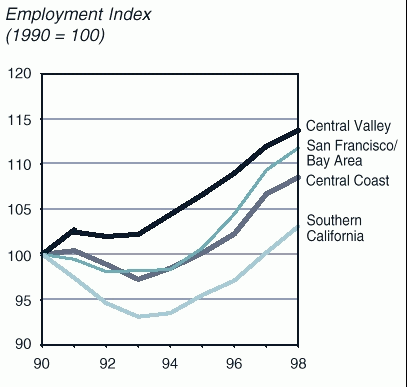
-
Economic performance in the 1990s has varied markedly among California’s major geographic regions.
-
The statewide economic downturn was felt most severely in Southern California, which was hit by dramatic declines in its aerospace and construction industries.
-
The subsequent economic recovery started earlier and has generally been stronger in the north than in the south, partly due to the impact of the high-technology boom on businesses within the Silicon Valley region in the San Francisco Bay Area.
Divergent Trends in Aerospace and High-Tech Industries
(Jobs in Thousands)
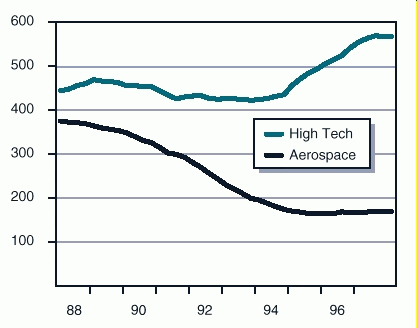
- Over the past decade, computer-related employment has increased by nearly 160,000 jobs.
-
During the same time period, the conclusion of the cold war resulted in a 200,000 job decline in California’s aerospace industry.
-
These two developments explain much of the divergent economic trends between Northern and Southern California in the 1990s. The majority of the state’s high-tech industries are located in the Bay Area, while the majority of the aerospace industry jobs that were lost were in Southern California.
Asia Accounts for Large Portion Of California's Exports
1997
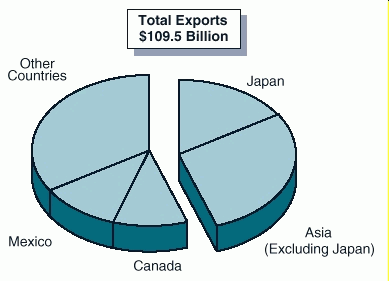
- One of the major risks to California's economic outlook involves the impact of Asia's financial and economic problems.
- Problems in Asia are of particular importance to California since nearly one-half of California's exports are to Japan and other Asian countries (primarily
those on the Pacific Rim).
- In 1997, slowing California exports to Asia were offset by increased sales to Canada, Mexico, and European markets.
- However, there is emerging evidence that Asia's problems are significantly affecting sales and profits of numerous California industries in 1998.
Large Geographic Variations Exist In California Housing Prices
Median Sales Price
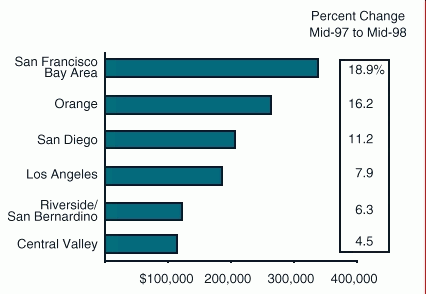
- There is tremendous variation in California's real estate markets. Median home prices range from the low $100,000s in the state's inland regions, up to
$340,000 in the San Francisco Bay Area.
- After several years of price declines in the early- and mid-1990s, real estate prices turned upward in the coastal regions in 1996, and in other regions in 1997
and 1998.
- The strong demand for new homes has led to a recovery in new construction activity throughout the state.
New Residential Construction On Rebound
(In Thousands)
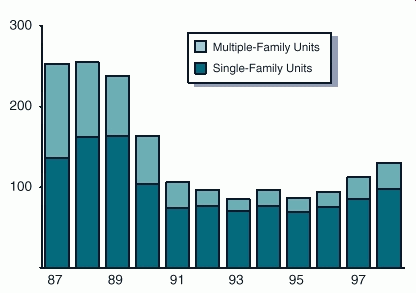
- One of the hardest-hit industries in California during the early 1990s was residential building.
- Permits for new single family and multifamily homes fell from over 200,000 units annually in the 1980s to below 100,000 per year through the first six years
of the 1990s.
- Building activity finally started to recover in 1997, and continues to climb in 1998, spurred by rising population, jobs, and incomes. However, current
building rates are still well below those of prior decades.
Central Valley Dominates Agricultural Production in California
Top Counties by Value of 1997 Production
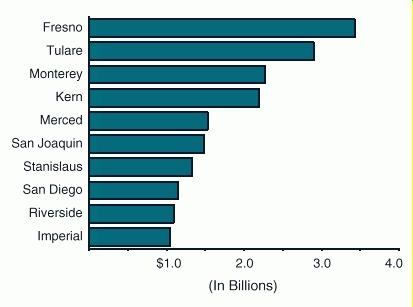
- With total production of over $26 billion, California is the largest agricultural producer in the United States.
- Over 350 different crops and commodities are produced in this state. California growers produce nearly 39 million tons of fruits, nuts, and vegetables,
accounting for more than half of U.S. production.
- The Central Valley region dominates agricultural production in California. Six of the top seven counties in the state are from this region.
Continue to 1998 Cal Facts California's Demographics
Return to 1998 Cal Facts Table of Contents
Return to LAO Home Page










